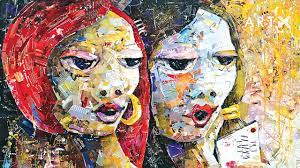Nigerian contemporary artists are the artists of today who produced arts in the 21st century. They work in a globally influenced, culturally diverse, and technologically advancing world. In this article, I will give the list of the Nigerian contemporary artists and all you need to know about them.
In this article we would be looking at List of Nigeria Contemporaray Artists
List of Nigerian Contemporary Artists
- Peju Alatise
- Marie Kure
- Nnenna Okore
- Victoria Udondian
- Victor Ehikhamenor
- Aina Onabolu
- Akinola Lasekan
- Ben Enweonwu
- Etsu Ugbodaga
- Madam Ladi Kwali
- Bruce Onabrakpeya
- Lamidi Fakeye
Peju Alatise
Peju Alatise is an interdisciplinary artist, architect and author of two novels. She started her professional career as an architect while running a private art studio. These days, she is a leading voice in contemporary art on the African continent. Her practice is relentlessly experimental and labour-intensive. She produces works across a variety of mediums, techniques and materials, including but not limited to paintings, film, installations, sculptures. Her work is also pointedly political, often asking damning questions of, and provoking reflections about the times, the state of affairs at home and abroad. Alatise’s work has, in the past, explored exploitative labour practices in Nigeria, child rights with a focus on young girls, state-sanctioned violence against citizens, migration, and the policies that ensure that many die at sea, seeking a better life. Alatise produces through the lens of spirituality, Yoruba cosmology, leaning into ancient storytelling traditions and crafting alternative social imageries.
Marie Kure
Marcia Kure was born in Nigeria. She lives and works in the United States and Nigeria. Trained at the University of Nigeria, she is an alumna of Skowhegan School of Painting and Sculpture. In addition to one-person exhibitions in Nigeria, Germany, the Netherlands, England, and the USA, her work was shown at La Triennial, Paris (2013), International Biennial of Contemporary Art, Seville (2006), and Sharjah International Biennale (2005). She presented her work at the 11th Dak’art, Biennale of Dakar, Senegal, in 2014 and was part of the traveling group show, Body Talk, Wiels Contemporary Art Center, Brussels, Frac Lorraine, France, and Lunds Konsthall, Sweden. A group show, Not a Single Story, Wanås Konst, Sweden and Nirox Sculpture Park, Johannesburg, 2018-19A Visiting Professor at the Royal Art Institute, Stockholm, Sweden (2019-20), research fellow of the Smithsonian Institution (2008), Visual Artist in Residence at the Victoria and Albert Museum (2014) and winner of Uche Okeke Prize for Drawing (1994), Kure’s work is in the collection of the British Museum, Centre Georges Pompidou, the National Museum of African Art, Smithsonian Institution, Newark Museum, The Hood Museum, Spelman College Museum of Fine Art, North Carolina Museum of Art, The Studio Museum, Harlem, IWALEWA-Haus and Frac Lorraine.
Nnenna Okore
Nnenna Okore was born in Australia, raised in Nigeria, and works between the United States and Nigeria. Throughout her long creative and scholarly career, she has focused on ecological issues steeped in artistic practice, learning, and social engagements. Okore has been involved in numerous participatory art projects and exhibitions designed to produce dialogue, art-making, and an awareness of current environmental issues. In her most recent art project, she uses bioplastic made from food waste and environmentally friendly materials to create new works of art. Okore, who is passionate about generating dialogue on environmental issues, is involved in numerous collaborative environmental projects across Nigeria, Australia, and the United States. Nnenna Okore is a Professor at Chicago’s North Park University. She earned her B.A degree from the University of Nigeria, Nsukka (First Class Honors) in 1999, and her MA and MFA at the University of Iowa, in 2004 and 2005 respectively.
Victoria Udondian
Udondian creates work that questions notions of cultural identity and post-colonial positions in relation to her experiences growing up in Nigeria, a country flooded with cast-off from the West. Her work is driven by her interest in textiles and the potential for clothing to shape identity, informed by the histories and tacit meanings embedded in everyday materials. She engages with repurposed material to investigate how fundamental changes in fabrics can affect one’s perception of identity. Udondian’s works have been exhibited internationally in Lagos, Venice, New York, the UK, etc. These include The Inaugural Nigerian Pavilion at the 56th Venice Biennial-An Excerpt, Fisher Landau Centre for the Arts, New York; The Children Museum of Manhattan, New York; National Museum, Lagos and Lokoja; Whitworth Gallery in Manchester etc. Some of her Artist Residencies include, Instituto Sacatar, Bahia, Brazil; Mass Moca, Massachusetts, USA; Fine Arts Work Centre (FAWC), Provincetown; USA; Fondazione di Venezia, Venice and Bag Factory Studios, Johannesburg. Udondian received an MFA in Sculpture and New Genres from Columbia University, New York, attended Skowhegan School of Painting and Sculpture and a BA in painting from the University of Uyo, Nigeria. He lives and works in Lagos and New York.
Victor Ehikhamenor
Victor Ehikhamenor is a Nigerian multimedia artist, photographer, and writer. He has been prolific in producing abstract, symbolic, and politically/historically motivated works. A 2020 National Artist in Residence at the Neon Museum, Las Vegas, Nevada, Ehikhamenor is also a 2016 Rockefeller Foundation Bellagio Fellow. He has held several solo exhibitions and his works have been included in numerous group exhibitions and biennales, including the 57th Venice Biennale as part of the Nigerian Pavilion (2017), 5th Mediations Biennale in Poznan, Poland (2016), The 12th Dak’art Biennale in Dakar, Senegal (2016), Biennale Jogja XIII, Indonesia (2015).
Father of Contemporary Artists in Nigeria
The man who began or first made art in Nigeria is Aina Onabolu. He was born in Ijebu-Ode in 1882. Onabolu started painting at the early age of 12, and his artwork was inspired by the cheap re-produced illustrations of Western arts which were prominent in many Nigerian magazines and religious books. He was a pioneering Nigerian modern arts teacher and painter who was an important figure in the introduction of arts into the curriculum of secondary schools in the country. His portrait of Mrs. Spencer Savage in 1906 is sometimes credited as one of the earliest outstanding works of art that used a western and modern style and technique.
Similarly, Ben Enwonwu is Africa’s greatest contemporary artist. He was named Africa’s greatest contemporary artist by Time magazine. Ben is the first Nigerian artist to gain international and arguably Africa’s most influential artist of the 20th century.
I hope you find this article helpful as well as interesting



